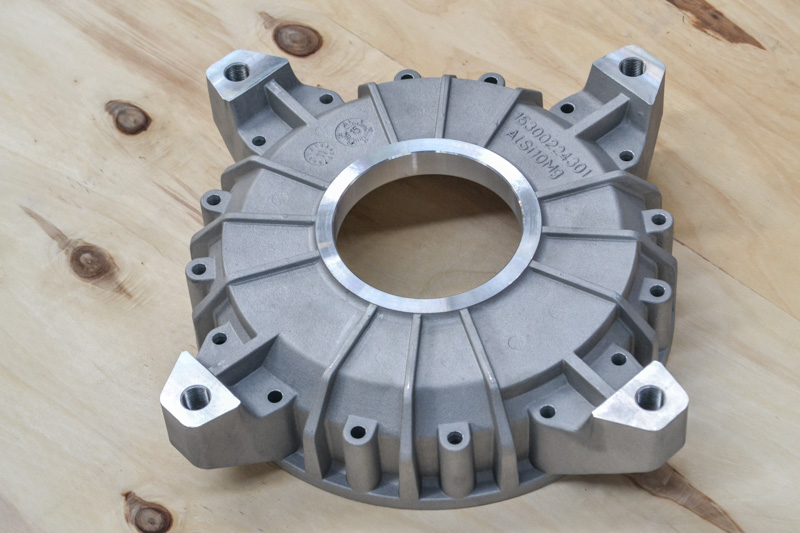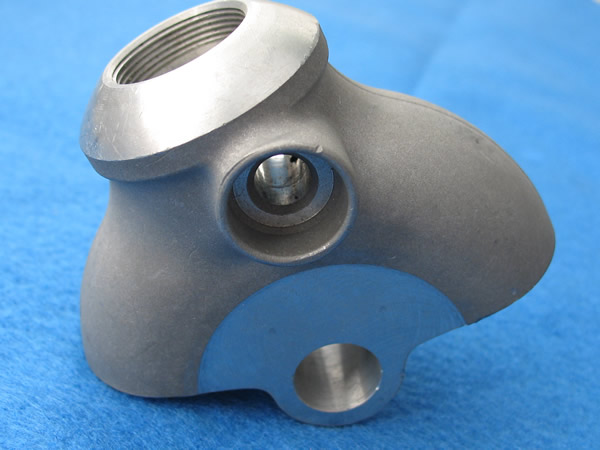Aluminum Castings and sustainable materials: What’s new?
The Function of Aluminum Casting in Progressing Lasting Manufacturing Practices
Aluminum casting serves as a crucial element in advertising lasting manufacturing practices. Its capability to create high-grade components with a minimized ecological footprint is amazing. The process not only supports energy efficiency but additionally significantly enhances recyclability. However, challenges remain in fully realizing its potential. Discovering the technologies in aluminum casting modern technology can expose services that align producing with sustainability goals. The ramifications of these developments are worth taking into consideration.
Recognizing Aluminum Casting and Its Refine
Although aluminum casting has actually been an essential process in manufacturing for decades, its significance proceeds to expand in different industries as a result of its flexibility and efficiency. This process entails putting liquified aluminum into mold and mildews to create intricate forms and components, making it excellent for generating light-weight yet long lasting products. The aluminum casting process can be categorized right into several techniques, including sand casting, pass away casting, and investment casting, each offering unique benefits fit to particular applications.
Throughout the casting procedure, aluminum is heated to its melting factor, allowing it to move easily right into mold and mildews that define the last shape. When cooled down, the aluminum solidifies, causing a strong and accurate part. The capability to generate complex geometries with marginal waste underscores aluminum casting's function in modern-day production - Aluminum Castings. As industries look for cutting-edge services, recognizing this procedure becomes essential for enhancing manufacturing and meeting the demands of a progressing market
Environmental Benefits of Aluminum Casting
As markets significantly prioritize sustainability, the environmental benefits of aluminum casting come to be more pronounced. One considerable advantage is the material's recyclability; aluminum can be recycled repetitively without degrading its high quality. This minimizes the quantity of waste sent out to landfills and reduces the need for virgin products, preserving natural deposits. Additionally, the aluminum casting process generates fewer greenhouse gas emissions compared to other metal casting methods, adding to lower overall ecological influence.
An additional advantage exists in the light-weight nature of aluminum, which leads to sustain performance in transport applications. By making use of aluminum parts, suppliers can lower lorry weight, resulting in decreased gas consumption and exhausts throughout procedure. Moreover, developments in aluminum casting innovations have actually caused a reduction in contaminated materials manufacturing, enhancing overall environmental safety. Collectively, these elements placement aluminum casting as a crucial player in promoting sustainable production techniques and conference ecological goals across numerous industries.
Energy Effectiveness in Aluminum Production
Power efficiency plays an essential duty in aluminum manufacturing, considerably impacting general sustainability. By embracing innovative casting strategies and incorporating renewable power sources, suppliers can accomplish reduced power intake throughout the production process. This change not only decreases operational prices but additionally adds to a more eco friendly market.

Minimized Energy Consumption
While the aluminum production sector has actually commonly been energy-intensive, current developments have actually substantially enhanced energy performance throughout the production process. Technologies in smelting modern technology and the adoption of high-efficiency furnaces have substantially decreased power usage. These enhancements permit makers to utilize much less energy per device of output, decreasing greenhouse gas discharges and lowering functional prices. In addition, the integration of sustainable power sources right into production facilities additionally contributes to lowered reliance on nonrenewable fuel sources, promoting sustainability. Carrying out advanced insulation products and maximizing warm healing systems likewise plays a necessary role in making the most of power efficiency. Therefore, the aluminum sector is making substantial strides toward minimizing its overall environmental footprint while meeting the enhancing demand for lasting techniques in manufacturing.
Innovative Casting Methods
Ingenious casting techniques are changing the aluminum production landscape, enhancing both effectiveness and sustainability. Advanced techniques such as die casting and investment casting minimize material waste and enhance dimensional precision, leading to lowered power consumption throughout the production procedure. Strategies like rapid solidification and semi-solid processing allow for far better control over metallurgical buildings, leading to lightweight and high-strength elements. Additionally, the execution of computer simulations and automation in casting procedures maximizes cycle times and lowers problem rates. These advancements not just enhance production but also add to the round economy by making it possible for the recycling of aluminum scrap into premium products. As an outcome, the aluminum market is positioned to fulfill growing demands while adhering to sustainable manufacturing methods.
Renewable Energy Combination
A substantial shift towards renewable resource integration is improving energy performance in aluminum manufacturing. This modification entails utilizing solar, wind, and hydropower sources to decrease reliance on fossil fuels, greatly reducing carbon exhausts. Facilities are progressively taking on energy-efficient innovations, such as innovative electrolytic procedures, which maximize energy intake during aluminum manufacturing. By using renewable resource, producers not only lower functional prices but additionally improve their sustainability accounts. In addition, smart grid innovations facilitate the smooth assimilation of eco-friendly sources, enabling even more secure energy supplies. As the sector accepts these innovations, the aluminum industry is positioned to lead in news sustainable practices, showing a dedication to ecological stewardship while fulfilling boosting global demand for lightweight, high-performance products.
The Recyclability of Aluminum and Its Influence
Aluminum's recyclability provides significant advantages in lasting production, permitting for limitless recycling without loss of high quality. This residential property not only reduces waste however likewise boosts energy efficiency during the reusing procedure. As a result, the effect on both the atmosphere and production costs is profound, making aluminum a favored product in eco-conscious industries.
Infinite Recycling Prospective
Although lots of products lose quality with reusing processes, aluminum sticks out as a result of its limitless recyclability, which read the article considerably adds to sustainable manufacturing techniques. This unique particular permits aluminum to be reused continuously without weakening its properties, making it a beneficial resource in various markets. The lifecycle of aluminum starts once more with each recycling effort, conserving raw materials and decreasing waste. This not only minimizes the environmental influence yet likewise cultivates a round economic situation where aluminum can be recycled many times. The high need for recycled aluminum even more stresses its relevance in sustainable manufacturing, as it improves resource effectiveness and advertises an environment-friendly strategy to manufacturing. Ultimately, the unlimited recycling capacity of aluminum plays a substantial role in progressing lasting practices throughout markets.

Power Performance Perks
Considerable power financial savings are understood with the recycling of aluminum, highlighting its duty in sustainable production. Recycling aluminum calls for just 5% of the power required to create brand-new aluminum from resources. This significant reduction in energy intake converts right into reduced greenhouse gas emissions, adding to ecological sustainability. The power performance of aluminum reusing not just saves sources find this but also lowers operational prices for manufacturers, making it a financially practical option. In addition, the procedure of recycling aluminum can be incorporated right into existing manufacturing lines without considerable disturbance, enhancing total efficiency. As sectors increasingly focus on sustainability, the recyclability of aluminum placements it as a crucial gamer ahead of time energy-efficient manufacturing techniques, cultivating a round economic situation and promoting liable resource monitoring.
Difficulties Dealing With Aluminum Casting in Sustainable Practices
While the aluminum casting industry has actually made strides towards sustainable practices, several challenges remain that prevent its development. One substantial issue is the high power intake connected with traditional casting techniques, which commonly depends on fossil gas. This dependancy not only enhances operational prices but likewise adds to greenhouse gas emissions. Additionally, the recycling process for aluminum can be inefficient, bring about material loss and boosted waste. Another difficulty is the restricted availability of sustainable resources, as sourcing recycled aluminum can be hard and costly. Regulative pressures and varying environmental requirements across areas complicate compliance initiatives, making it challenging for firms to adopt consistent sustainable methods. Labor force training continues to be poor, with several workers doing not have the required abilities to execute ingenious, green techniques in casting processes. Resolving these obstacles is vital for the aluminum casting sector to completely understand its capacity in sustainable production.
Developments in Aluminum Casting Modern Technology
To get rid of the obstacles faced in sustainable techniques, the aluminum casting sector is experiencing a wave of innovations focused on enhancing efficiency and lowering environmental influence. Advanced casting techniques, such as 3D printing and die casting, are being embraced to lessen product waste and improve precision. These modern technologies make it possible for manufacturers to produce complicated geometries with much less aluminum, consequently saving resources.
Additionally, the integration of recycling methods, consisting of closed-loop systems, facilitates using scrap aluminum, greatly decreasing power consumption contrasted to main aluminum production. Improved mold and mildew styles and layers are also adding to sustainability by boosting thermal effectiveness and reducing emissions throughout the casting process.
In addition, automation and wise manufacturing technologies are being applied to enhance production procedures, resulting in minimized cycle energy and times use. Jointly, these innovations stand for a substantial change in the direction of even more lasting methods within the aluminum casting sector, aligning with more comprehensive ecological objectives.
Future Potential Customers for Lasting Manufacturing With Aluminum Casting
As the need for sustainable production methods magnifies, the aluminum casting sector is poised to play a pivotal role fit a greener future. The industry is increasingly taking on reusing procedures that considerably lower waste and energy consumption, lining up with international sustainability goals. Developments such as low-energy casting strategies and the usage of recycled aluminum not only lessen carbon footprints yet also improve the overall efficiency of manufacturing.

As markets seek to comply with more stringent environmental regulations, the aluminum casting sector stands prepared to provide lasting options, placing itself as a key player in the change towards eco-friendly production techniques in various fields, consisting of vehicle and aerospace.
Often Asked Questions
Just How Does Aluminum Casting Compare to Other Metal Casting Techniques?
Aluminum casting typically provides benefits such as reduced melting points and exceptional recyclability contrasted to various other metal casting methods. Its light-weight nature and excellent deterioration resistance better improve its charm in various manufacturing applications.
What Industries Benefit The Majority Of From Aluminum Casting?
Numerous sectors, consisting of automotive, aerospace, and durable goods, considerably gain from aluminum casting - Aluminum Castings. This approach's lightweight, corrosion-resistant homes boost product efficiency while enabling detailed styles, making it an appealing alternative for producers looking for efficiency and innovation
Can Aluminum Casting Be Made Use Of for Complex Layouts?
Aluminum casting can properly suit complex styles because of its versatility and ability to form detailed forms. This procedure enables makers to create lightweight, resilient components ideal for different applications throughout various markets, improving technology and efficiency.
What Is the Life Expectancy of Aluminum Cast Products?
The life-span of aluminum cast items generally varies from a number of years to over a century, depending on factors such as environmental problems, maintenance, and the certain application. Sturdiness makes them appropriate for numerous long-lasting uses.
Just How Does Aluminum Casting Effect Task Development in Production?
Aluminum casting substantially contributes to task creation in manufacturing by fostering experienced labor chances, supporting neighborhood economies, and encouraging technical improvements. This procedure not only improves production effectiveness but also promotes workforce advancement and training efforts.